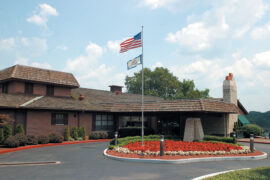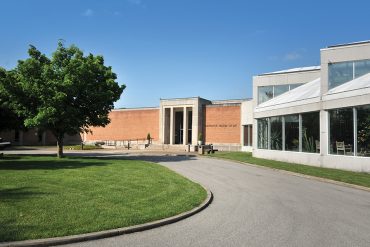Charlene Farrell has spent the last 25 years helping patients and their families face life’s final chapter
By Carter Seaton
HQ 67 | WINTER/SPRING 2009
All these superlatives have been used to describe the dynamic President and CEO of Hospice of Huntington, Charlene Farrell, and her dedicated leadership of the non-profit organization for the past 25 years. But for her it’s not a job; it’s a calling.
Although there were no nurses in her extended Huntington family, the nurturing she received from her mother during childhood set the former Charlene Linsenmeyer on a path to care for others. “When we were sick she was just like an angel,” she says. Educated at St. Joseph’s Catholic Schools and influenced by the Sisters, Charlene briefly considered becoming a nun, then decided to serve another way. As a teenage Candy Striper at St. Mary’s Hospital, she saw for the first time children who were sick with more than mere childhood maladies. That moved her deeply and made her want to help. In 1967 she went to Mount St. Joseph’s College in Cincinnati for her nursing degree, while high school sweetheart and future husband, Paul, attended Xavier University in the same city. After graduation, the newly-licensed nurse worked briefly at Cabell Huntington Hospital before she and Paul were married in October 1971.
Many of Charlene’s nursing experiences forged the skills and empathy she needed for her current post. In North Carolina, where they lived while Paul completed his military obligation, she saved a co-workers’ life by performing CPR without a physician present. At Eastern Kentucky University, as the clinical obstetrics instructor, she was sometimes called on to deliver babies while her students watched. In Morgantown, while Paul earned his law degree at West Virginia University, she taught cancer surgery patients how to care for themselves after discharge, then made occasional home visits to check on them. When Paul became Assistant Attorney General in 1978 under Attorney General Chauncey H. Browning, Jr., Charlene worked in the Surgical Intensive Care Unit at Charleston Area Medical Center. There, before the hospice movement developed, she championed home health care for people who were seriously ill or dying.
Her first and, perhaps, most profound experience with end of life occurred while she was still a student, however. Assigned to a gentleman who was very short of breath, she didn’t understand that he was imminently dying. She left the floor for her lunch break and upon her return, discovered he had died.
“I can remember sitting with his recent widow and being just so sorry that I had left when I did,” she recalls.

That feeling never left her. Her ICU experiences with people dying while isolated from their family members had a marked affect, as well. She knew there had to be a better way. When a family member was able to die at home with loved ones, Charlene saw it as a step forward, but saw that adequate resources for proper patient care still were not readily available.
When the Farrells returned to Huntington, Charlene taught nursing at Marshall University until she became pregnant with their third son. “I was home with Sean and really praying about what I should do now,” she remembers. “I had made a list of all the things I thought were important to me. I wanted to be involved with taking care of people who were seriously ill and perhaps dying; and I wanted to be able to interact with them at home. About that time, Laura Darby called me.” And the rest, as they say, is history. Or God’s will, as Charlene prefers. “What prompted Laura to call me, I have no idea. It was an answer to a prayer,” she says. “It was a series of events that I could see the Lord’s hand in, because why would she call me just when I was making that list?”
Why, indeed? A few years earlier Laura had been one of Charlene’s nursing students and in 1982 had established Hospice of Huntington as her independent senior project. Now, one year later, with the organization firmly launched, Laura had decided to step aside as its Executive Director and called Charlene.
“She first asked me to be the patient-care coordinator and to do some nursing,” Charlene says. “Then she called back and said, ‘I really want you to be the Executive Director.'”
Actually Charlene had to apply for the position, but according to Dr. David Daniels, who was on the Hospice planning committee, it was hers for the taking. He urged her to do so. Charlene disagrees. “I think they hired me because I was willing.”
But those who have worked with Charlene would challenge that. Dr. Daniels, who retired as Medical Director of Hospice, says, “Charlene has been a master at working all the business operations. She knows, as the nuns at St. Mary’s say, ‘No money, no mission.'” Hospice of Huntington had $20,000 in the bank when Charlene was hired for the part-time position – much less than she was making as an RN – but she was following her passion.
Today Hospice offers four levels of care: general inpatient care, respite care for the family or caregivers in a hospital, round the clock nurses at home and routine visits. Social workers, home health aides and therapists provide the necessary care, but none of those were in place when she took over. Within two years, she had put systems in place to manage staffing, billing, funding streams and organizational survival. She had written contracts with hospitals and ambulance companies, and the organization had become the first Medicare-certified Hospice in the state.
In 1993, with the encouragement of Board Treasurer John Kinzer, Charlene entered Marshall University to earn an MBA in order to better manage the growing non-profit corporation.
“She was a nurse and she fretted about finances. She’d come to every board meeting with these numbers and she’d be concerned,” says the former Arch Coal executive. “I finally convinced her that she should look at a three to six months trend instead of only one month.” Today, under Charlene’s skillful hand, the annual budget is $12 million, the staff tops 150, and there are hundreds of dedicated volunteers.
According to fellow nursing instructor and former Chief Operating Officer of St. Mary’s Medical Center, Sharon Ambrose, “Charlene’s motivation and belief in the project is another strength. She’s able to sell that to others.” With that same passion, Charlene planned every detail of Hospice House, which opened in May 2006. According to Dr. Daniels, she made the decision to have individual heating and cooling for each resident’s room, determined the room size, chose the furniture, selected the decorations, and did a masterful job of it all.
As a dedicated wife, mother of three grown sons, and grandmother of five, you’d think her volunteer time would be limited, but you’d be wrong. Since her days in North Carolina, she’s been a dedicated Red Cross volunteer nurse. After the attacks of September 11, she went to New York City to help. “It was providing bereavement counseling, it was support, it was listening to their stories. It was everything we do in Hospice after someone dies. It wasn’t the traditional role of a Red Cross nurse, but it was a profound experience.”

Similarly, as she and Paul watched the devastation of Hurricane Katrina, she was moved to volunteer. “Caring for people in that way brings every experience you’ve ever had in your life to bear. I think those experiences made me more sensitive and made me appreciate even more the resiliency of the human spirit. And it made me let go, to not sweat some of the small stuff.”
“Do what you love and you’ll never work a day in your life.” Is this familiar quote descriptive of Charlene Linsenmeyer Farrell’s career? “It is true for me,” Charlene says. “I just hope my story encourages someone to live out a dream and live out a passion and to do something that is very important to them. I think they hired me because I was willing and sometimes that’s what it takes – to be willing to do something you feel passionate about.”





